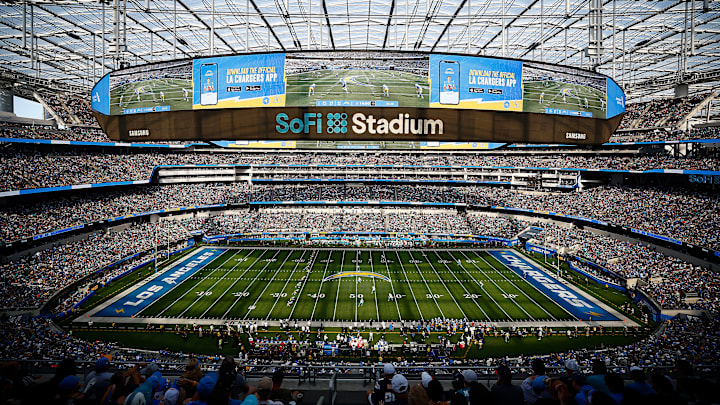The LA Chargers have only played in two cities but there has been a lot of controversy around where the team has played. With strong roots in San Diego, the decision to move back to Los Angeles in 2020 was a controversial one that split the fanbase.
All in all, the Chargers have played in five different stadiums across the two different cities that the franchise has called home. Here is everywhere the team has played.
Chargers stadium history:
Los Angeles Memorial Coliseum: 1960
Like today, the first stadium that the Chargers ever played in they shared with the Los Angeles Rams. The Chargers could not gain traction in Los Angeles with the Rams, who played in the NFL at the time, dominating the market.
Thus, after one disappointing season then-owner, Barron Hilton (yes, the same Hilton as the hotel chain) opted to move the Chargers south to San Diego. Meanwhile, the Rams continued to bring in huge crowds at the Coliseum as the lone team in Los Angeles (until the Raiders came around in 1982).
Balboa Stadium: 1961-1966
The first place the Chargers called home in San Diego was none other than Balboa Stadium. The century-old stadium hosted the Chargers for six years before the team packed up and moved to their long-time San Diego home.
The Chargers won the only championship in franchise history while playing at Balboa Stadium as the team won the AFL Championship in 1963.
San Diego Stadium/Jack Murphy Stadium/Qualcomm Stadium: 1967-2017
This entry should be referred to by all three of its names throughout the years because of how important each of the names were. What you called the Chargers' old stomping grounds in San Diego all depends on how old you are and when you became a fan.
If you are someone who became a fan of the Chargers during the early stages at the start or before the Air Coryell era then you call it San Diego stadium. If you became a fan during the Air Coryell era, after it, or during the team's lone Super Bowl run then you call it Jack Murphy Stadium. If you became a fan during the LaDainian Tomlinson era then you call it Qualcomm.
Either way, this is the most iconic stadium in franchise history and unfortunately, it no longer exists. The stadium was torn down in late 2020 and early 2021 to build SDSU's new, smaller-capacity, football stadium.
Dignity Health Sports Park: 2017-2019
This was a dark era for Chargers fandom. The move to Los Angeles was already a polarizing one for the Bolts and it did not help that the team decided to play in a soccer stadium until their new home would be finished.
This is when opposing fans would truly take over Chargers games. Disgruntled Chargers fans were not willing to shell out the abnormal ticket prices to go to a game in a non-football stadium. Visiting fans would take over and the Chargers earned the (untrue) reputation of not having a fanbase, with former players even chiming in.
SoFi Stadium: 2020-present
The Chargers played their first game at SoFi Stadium on September 20, 2020 (which was Justin Herbert's first career start). It was an unprecedented first game at the team's new home with zero fans in attendance due to the COVID-19 pandemic.
Once fans were allowed back they proved that the visiting-fan takeover at the soccer stadium was not going to happen at SoFi. Sure, big-market teams have been able to split the stadium 50/50 but it has been a much different environment at Sofi Stadium than it was at the team's first LA home.
Why did the Chargers play a game at Sun Devil Stadium in 2003?
The Chargers were forced to play a home game in Arizona at Sun Devil Stadium during the 2003 season due to the Cedar Fire.
The Cedar Fire burned over a quarter-million acres in the fall of 2003. Unfortunately, the Chargers were unable to win that Monday Night Football home game in Arizona, losing 26-10 to the Miami Dolphins.
